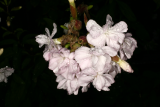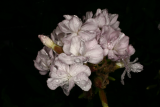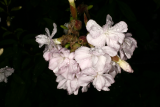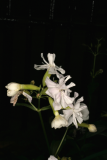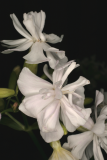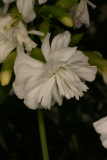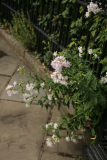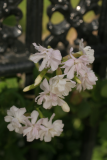Additional notes (click to expand)
Medicinal
In traditional herbal medicine the following notes apply to the species of this plants:
Soapwort's main medicinal use is as an expectorant. Its strongly irritant action within the gut is thought to stimulate the cough reflex and increase the production of a more fluid mucus within the respiratory passages[254].
http://www.pfaf.org, https://pfaf.org/user/plant.aspx?LatinName=Saponaria+officinalis
Other use
Saponaria officinalis L. Caryophyllaceae Cultivar 'Alba Plena' has double white flowers. Soapwort. Distribution: Europe. Linnaeus (1782) noted its use for weight loss, vaginal discharge, jaundice and parasitic intestinal worms [Ascaris lumbricoides]. The roots, crushed, lathered in water, were used as a soap substitute (Stearn, 1994), but Lyte (1578) says it is the leaves which were used. He writes that German swineherds give it chopped up to their pigs to protect them 'from the Murren' [i.e. 'murrain' the name used for all the fatal epidemics of cattle and sheep that swept Europe in the 14th century, causing the Great Famine of 1315-1317, and in later years]. As a medicine he thought it good against all chest conditions, 'venome and poyson', air-born infection and pestilence [the plague], and for healing wounds and ulcers.
Oakeley, Dr. Henry F. (2013). Wellcome Library notes.
link
Phytochemistry
The sap contains saponins, which act as deterrent against snails.
Sequin, M. (2012). The Chemistry of Plants. Perfumes Pigments and Poisons. Royal Society of Chemistry, Cambridge, UK.
Toxicity
Saponin content can cause colic, emesis, diarrhoea, intestinal damage and hepatotoxicity.
Professor Anthony Dayan, 2022
Saponaria officinalis 'Alba Plena'
Family: CARYOPHYLLACEAEGenus: Saponaria
Species: officinalis
Cultivar: 'Alba Plena'
Common names: Soapwort, Bouncing-bet, Crow Soap
Pharmacopoeia Londinensis name: Saponaria
Distribution summary: Eurasia
Habit: Perennial
Hardiness: H5 - Hardy; cold winter
Garden status: Currently grown
Garden location: Europe & Middle East (J)
Reason for growing: Medicinal, toxic
